Share your love
Full and Easy Steps to Set up OpenNMS on Debian 11
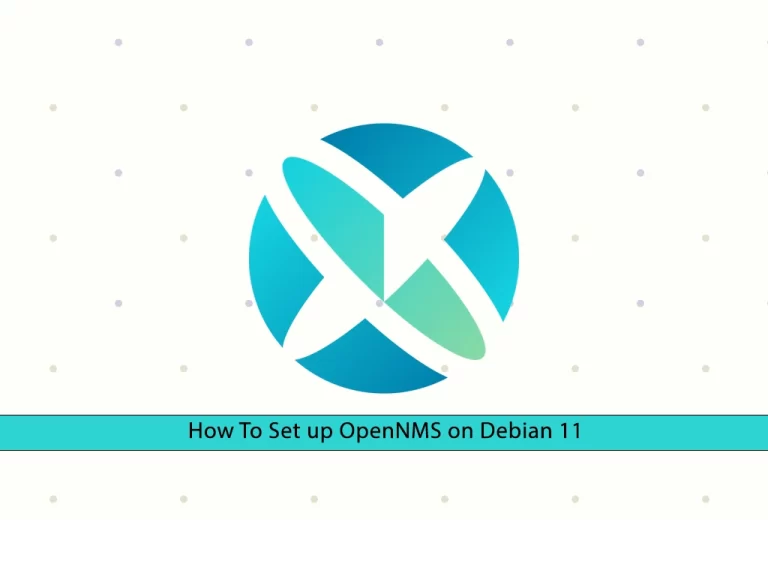
In this guide, we want to teach you to Set up OpenNMS on Debian 11. OpenNMS provides a highly reliable, scalable, and comprehensive fault, performance, and traffic monitoring solution that easily integrates with business applications and workflows to monitor and visualize everything in a network. The OpenNMS platform monitors some of the largest networks in existence, covering the healthcare, technology, finance, government, education, retail, and industrial sectors, many with tens of thousands of networked devices.
There are two types of OpenNMS – Meridian and Horizon. When we need stability and long-term support, choose Meridian, which is best for enterprises and businesses. Horizon is used where innovation occurs frequently. It is best for IT-ecosystem and new technologies monitoring.
Steps To Set up OpenNMS on Debian 11
To Set up OpenNMS on Debian 11, log in to your server as a non-root user with sudo privileges and set up a basic firewall. To do this, you can follow our guide on Initial Server Setup with Debian 11.
Install Java on Debian 11
Because OpenNMS is written in Java, you must install Java on your server. First, run the system update:
sudo apt updateNow use the command below to install Java on Debian 11:
sudo apt install default-jdk -yVerify your Java installation by checking its version:
java -versionOutput
openjdk version "11.0.18" 2023-01-17
OpenJDK Runtime Environment (build 11.0.18+10-post-Debian-1deb11u1)
OpenJDK 64-Bit Server VM (build 11.0.18+10-post-Debian-1deb11u1, mixed mode, sharing)
Set Java Environment Variables
At this point, you need to set the Java home path by using the command below:
sudo export JAVA_HOME=/usr/lib/jvm/java-1.11.0-openjdk-amd64Then, source the /etc/profile file:
sudo source /etc/profileSet up OpenNMS Horizon on Debian 11
The OpenNMS packages aren’t available in the default Debian repository. So you need to add it manually.
Import OpenNMS GPG Key
At this point, you need to use the following command to import the OpenNMS GPG key:
wget -O - https://debian.opennms.org/OPENNMS-GPG-KEY | sudo apt-key add -Add OpenNMS Repository
Then, you need to add the OpenNMS repo to your server by using the command below:
cat << EOF | sudo tee /etc/apt/sources.list.d/opennms.list
deb https://debian.opennms.org stable main
deb-src https://debian.opennms.org stable main
EOFInstall OpenNMS on Debian
Now you can easily use the command below to install and Set up OpenNMS on Debian 11:
# sudo apt update
# sudo apt -y install opennmsThis will install all the dependencies on your server.
Configure PostgreSQL for OpenNMS on Debian 11
When your dependencies and OpenNMS are installed on your server, you need to configure PostgreSQL.
First, verify your PostgreSQL is active and running on Debian 11:
sudo systemctl status postgresqlOutput
● postgresql.service - PostgreSQL RDBMS
Loaded: loaded (/lib/systemd/system/postgresql.service; enabled; vendor pr>
Active: active (exited) since Mon 2023-03-06 13:35:35 EST; 54s ago
Main PID: 7704 (code=exited, status=0/SUCCESS)
Tasks: 0 (limit: 4679)
Memory: 0B
CPU: 0
CGroup: /system.slice/postgresql.service
...Next, switch to your PostgreSQL user:
sudo su - postgresCreate OpenNMS Database and User
At this point, use the following command to create an OpenNMS user:
createuser -P opennmsEnter password for new role:
Enter it again: Then, create the OpenNMS database on Debian 11 by using the command below:
createdb -O opennms opennmsNext, protect the default user with a password:
psql -c "ALTER USER postgres WITH PASSWORD 'StrongPassword';"Output
ALTER ROLEExit the PostgreSQL shell:
[postgres@localhost ~]$ exitDefine database credentials in OpenNMS Config File
At this point, you need to define the database credentials in the OpenNMS config file. Open the file with your favorite text editor, here we use the vi editor:
sudo vi /usr/share/opennms/etc/opennms-datasources.xmlFind the lines below and define your database credentials:
<jdbc-data-source name="opennms"
database-name="opennms"
class-name="org.postgresql.Driver"
url="jdbc:postgresql://localhost:5432/opennms"
user-name="opennms"
password="opennms-user-password" />
<jdbc-data-source name="opennms-admin"
database-name="template1"
class-name="org.postgresql.Driver"
url="jdbc:postgresql://localhost:5432/template1"
user-name="postgres"
password="postgres-password" />
</datasource-configuration>When you are done, save and close the file.
Manage OpenNMS Service on Debian 11
First, you need to initialize OpenNMS by adding the Java settings:
sudo /usr/share/opennms/bin/runjava -sOutput
runjava: Looking for an appropriate JVM...
runjava: Checking for an appropriate JVM in JAVA_HOME...
runjava: Found: "/usr/lib/jvm/java-1.11.0-openjdk-amd64/bin/java" is an appropriate JVM.
runjava: Value of "/usr/lib/jvm/java-1.11.0-openjdk-amd64/bin/java" stored in configuration file.Next, initialize the database and detect system libraries in the /usr/share/opennms/bin/install directory:
sudo /usr/share/opennms/bin/install -disAt this point, you can use the following commands to start and enable your OpenNMS service:
# sudo systemctl start opennms
# sudo systemctl enable opennmsVerify your OpenNMS service is active and running on Debian 11:
sudo systemctl status opennmsOutput
● opennms.service - OpenNMS server
Loaded: loaded (/lib/systemd/system/opennms.service; enabled; vendor prese>
Active: active (running) since Mon 2023-03-06 13:42:29 EST; 10s ago
Main PID: 12875 (java)
Tasks: 130 (limit: 4679)
Memory: 446.2M
CPU: 34.477s
CGroup: /system.slice/opennms.service
├─12874 bash /usr/share/opennms/bin/opennms -s start
└─12875 /usr/lib/jvm/java-1.11.0-openjdk-amd64/bin/java --add-modu>
...Configure Firewall For OpenNMS
Here we assumed that you have enabled UFW. By default, OpenNMS is listening on port 8980. You have to allow this port through the firewall using the following command:
sudo ufw allow 8980/tcpReload the firewall to apply the changes:
sudo ufw reloadAccess OpenNMS Web Interface
At this point, you have learned to Set up OpenNMS on Debian 11. Now you can access OpenNMS Horizon through the Web interface on Debian 11 by typing your server’s IP address in your web browser followed by 8980/opennms:
http://your-server-ip:8980/opennmsYou will see the OpenNMS horizon login screen. Enter admin as the username and password and click Login.
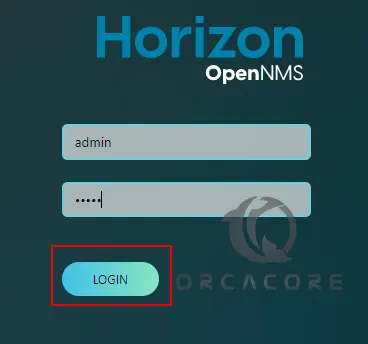
Then, you should see the OpenNMS Horizon dashboard on Debian 11.
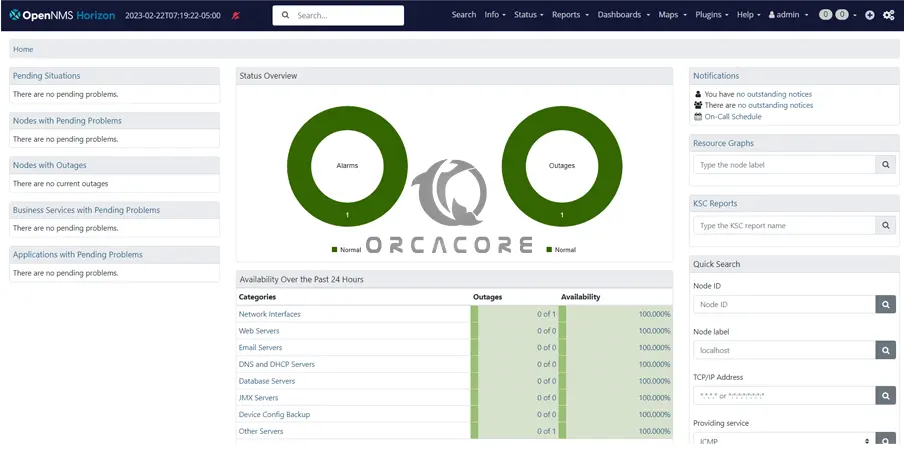
You can now change the password to a preferred one by navigating to admin → Change Password.
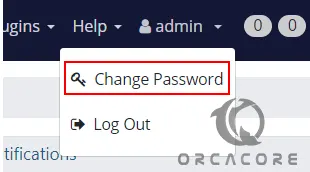
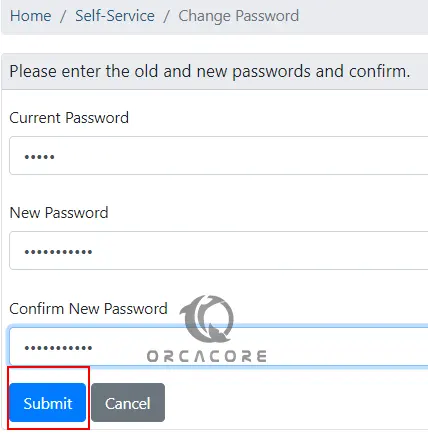
How To Monitor Systems with OpenNMS
To be able to monitor systems, you need to add them to OpenNMS. Begin by clicking on the “+“ icon as shown below.
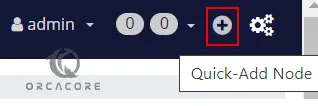
Enter the required details such as requisition, IP Address, and Node Label, and click Provision.
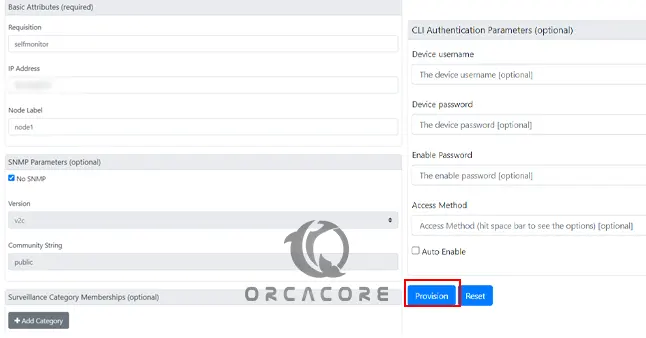
After the node has been added, it will appear under Info → Nodes.
You can now view graphs and create alerts for the device.
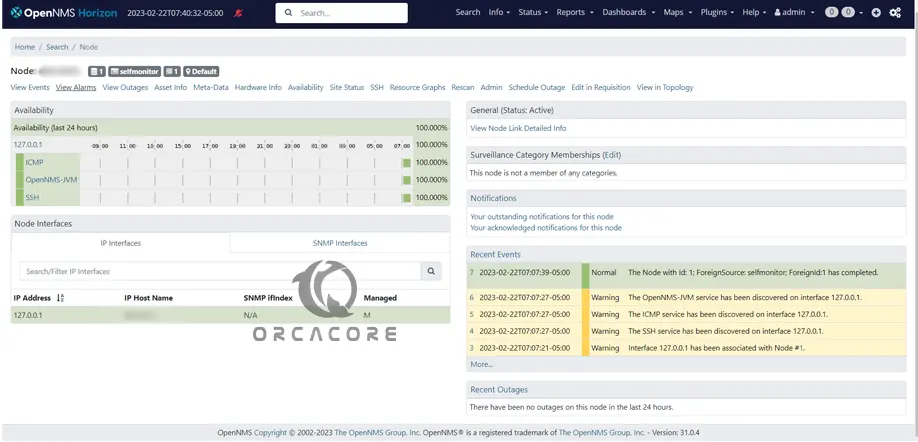
For more information, you can visit OpenNMS Documentation.
Conclusion
At this point, you have learned to Set up OpenNMS on Debian 11.
Hope you enjoy it. You may like these articles on the Orcacore website:



